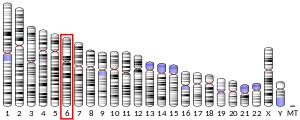
Potassium channel subfamily K member 1 is a protein that in humans is encoded by the KCNK1 gene.

Potassium channel subfamily K member 6 is a protein that in humans is encoded by the KCNK6 gene.

Cysteine-rich with EGF-like domain protein 1 is a protein that in humans is encoded by the CRELD1 gene.

Potassium channel subfamily K member 5 is a protein that in humans is encoded by the KCNK5 gene.

Potassium inwardly-rectifying channel, subfamily J, member 14 (KCNJ14), also known as Kir2.4, is a human gene.

SCAN domain-containing protein 3 is a protein that in humans is encoded by the SCAND3 gene.

Low-density lipoprotein receptor-related protein 10 is a protein that in humans is encoded by the LRP10 gene.

Potassium/sodium hyperpolarization-activated cyclic nucleotide-gated channel 3 is a protein that in humans is encoded by the HCN3 gene.

Thioredoxin-related transmembrane protein 1 is a protein that in humans is encoded by the TMX1 gene.

Enkurin domain-containing protein 1 is a protein that in humans is encoded by the ENKD1 gene.

Potassium voltage-gated channel subfamily G member 1 is a protein that in humans is encoded by the KCNG1 gene.

Claudin domain-containing protein 1 is a protein that in humans is encoded by the CLDND1 gene.

Plexin domain-containing protein 2 is a protein that in humans is encoded by the PLXDC2 gene.

Long-chain fatty acid transport protein 3 is a protein that in humans is encoded by the SLC27A3 gene.

Potassium voltage-gated channel subfamily G member 4 is a protein that in humans is encoded by the KCNG4 gene. The protein encoded by this gene is a voltage-gated potassium channel subunit.

Potassium voltage-gated channel subfamily H member 6 is a protein that in humans is encoded by the KCNH6 gene. The protein encoded by this gene is a voltage-gated potassium channel subunit.

Voltage-gated potassium channel subunit beta-3 is a protein that in humans is encoded by the KCNAB3 gene. The protein encoded by this gene is a voltage-gated potassium channel beta subunit.

Chloride channel accessory 4, also known as CLCA4, is a protein which in humans CLCA4 gene. The protein encoded by this gene is a chloride channel. Protein structure prediction methods suggest the N-terminal region of CLCA4 protein is a zinc metalloprotease, and the protein is not an ion channel per se.

Dipeptidase 3 (DPEP3) is a protein that in humans is encoded by the DPEP3 gene.

CYP4X1 is a protein which in humans is encoded by the CYP4X1 gene.











